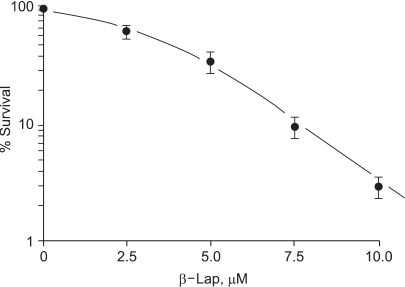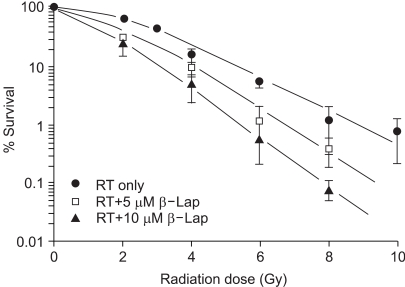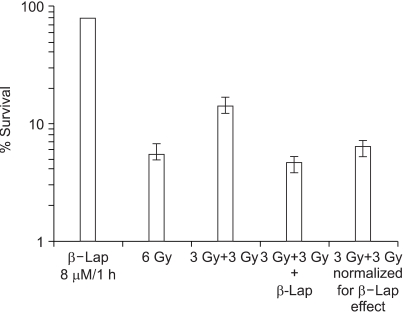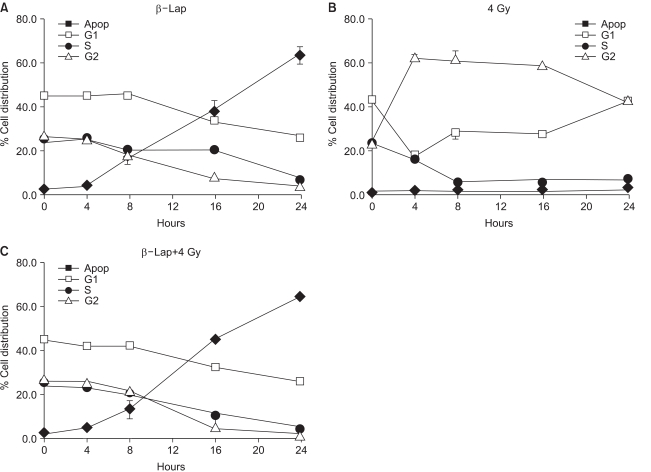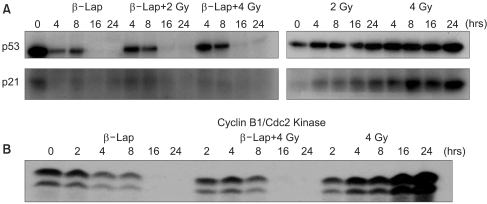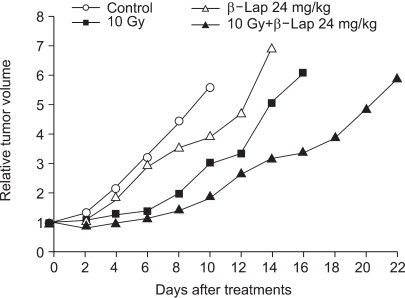Cancer Res Treat.
2005 Jun;37(3):183-190.
Synergistic Effect of Ionizing Radiation and beta-lapachone against RKO Human Colon Adenocarcinoma Cells
- Affiliations
-
- 1Department of Microbiology, College of Medicine, Inha University, Incheon, Korea. park001@inha.ac.kr
- 2Department of Therapeutic Radiology, College of Medicine, University of Ulsan, Seoul, Korea.
- 3Department of Statistics College of Medicine, Inha University, Incheon, Korea.
- 4Radiobiology Laboratory, Department of Therapeutic Radiology, University of Minnesota Medical School, Minneapolis, MN, USA.
- 5Department of Radiation Oncology, College of Medicine, Inje University, Busan, Korea.
Abstract
- PURPOSE
To reveal the interaction between beta-Lapachone (beta-lap) and ionizing radiation in causing cell death in RKO human colon adenocarcinoma cells, and to elucidate the potential usefulness of combined beta-lap treatment and radiotherapy for cancer treatment. MATERIALS AND METHODS: The cytotoxicities of various treatments were determined in vitro using clonogenic and apoptotic cell death. The changes in cell cycle distribution were studied using flow cytometry and an in vitro kinase assay. The tumor growth was studied using RKO tumors grown s.c. in the hind leg BALB/c- nuslc nude mice. RESULTS: beta-lap caused clonogenic cell death and rapid apoptosis in RKO cells in vitro, in a dose dependent manner. The repair of sublethal radiation damage was almost completely inhibited when cells were maintained in beta-lap during the interval between the two-dose irradiation. Flow cytometry study demonstrated that beta-lap induced apoptosis, independent of the cell cycle phase, and completely prohibited the induction of radiation- induced G2 arrest in irradiated cells. The prohibition of radiation-induced G2 arrest is unclear, but may be related to the profound suppression of the p53, p21 and cyclin B1-Cdc2 kinase activities observed in cells treated with beta-lap. The combination of beta-lap and radiation markedly enhanced the radiation-induced growth suppression of tumors. CONCLUSION: beta-lap is cytotoxic against RKO cells, both in vitro and in vivo, and also sensitized cells to ionizing radiation by inhibiting sublethal radiation damage repair. beta-lap is potentially useful as a potent anti-cancer chemotherapy drug and potent radiosensitizer against caner cells.
Keyword
MeSH Terms
Figure
Reference
-
1. Pardee AB, Li YZ, Li CJ. Cancer therapy with β-lapachone. Curr Cancer Drug Targets. 2002; 2:227–242. PMID: 12188909.2. Planchon SM, Wuerzberger S, Frydman B, Witiak DT, Hutson P, Church DR, et al. β-lapachone-mediated apoptosis in human promyelocytic leukemia (HL-60) and human prostate cancer cells: a p53-independent response. Cancer Res. 1995; 55:3706–3711. PMID: 7641180.3. Tagliarino C, Pink JJ, Dubyak GR, Nieminen AL, Boothman DA. Calcium is a key signaling molecule in beta-lapachone-mediated cell death. J Biol Chem. 2001; 276:19150–19159. PMID: 11279125.4. Wuerzberger S, Pink JJ, Planchon SM, Byers KL, Bornmann WG, Boothman DA. Induction of apoptosis in MCF-7: WS8 breast cancer cells by beta-lapachone. Cancer Res. 1998; 58:1876–1885. PMID: 9581828.5. Pink JJ, Wuerzberger-Davis S, Tagliarino C, Planchon SM, Yang X, Froelich CJ, et al. Activation of a cysteine protease in MCF-7 and T47D breast cancer cells during β-lapachone mediated apoptosis. Exp Cell Res. 2000; 25:144–155. PMID: 10694431.6. Li CJ, Li YZ, Pinto AV, Pardee AB. Potent inhibition of tumor survival in vivo by beta-lapachone plus taxol: combining drugs imposes different artificial checkpoints. Proc Natl Acad Sci USA. 1999; 96:13369–13374. PMID: 10557327.7. Boothman DA, Trask DK, Pardee AB. Inhibition of potentially lethal DNA damage repair in human tumor cells by beta-lapachone, an activator of topoisomerase I. Cancer Res. 1989; 49:605–612. PMID: 2535961.8. Pink JJ, Planchon SM, Tagliarino C, Varnes ME, Siegel D, Boothman DA. NAD(P)H: Quinone oxidoreductase activity is the principal determinant of beta-lapachone cytotoxicity. J Biol Chem. 2000; 275:5416–5424. PMID: 10681517.9. Planchon SM, Pink JJ, Tagliarino C, Bornmann WG, Varnes ME, Boothman DA. β-lapachone-induced apoptosis in human prostate cancer cells: involvement of NQO1/xip3. Exp Cell Res. 2001; 267:95–106. PMID: 11412042.
Article10. Planchon SM, Wuerzberger-Davis SM, Pink JJ, Robertson KA, Bornmann WG, Boothman DA. Bcl-2 protects against beta-lapachone-mediated caspase 3 activation and apoptosis in human myeloid leukemia (HL-60) cells. Oncol Rep. 1999; 6:485–492. PMID: 10203579.
Article11. Li YZ, Li CJ, Pinto AV, Pardee AB. Release of mitochondrial cytochrome C in both apoptosis and necrosis induced by β-lapachone in human carcinoma cells. Mol Med. 1999; 5:232–239. PMID: 10448645.
Article12. Huang L, Pardee AB. Beta-lapachone induces cell cycle arrest and apoptosis in human colon cancer cells. Mol Med. 1999; 5:711–720. PMID: 10656873.13. Li Y, Sun X, La Mont JT, Pardee AB, Li CJ. Selective killing of cancer cells by β-lapachone direct checkpoint activation as a strategy against cancer. Proc Natl Acad Sci. 2003; 100:2674–2678. PMID: 12598645.
Article14. Boorstein RJ, Pardee AB. Beta-Lapachone greatly enhances MMS lethality to human fibroblasts. Biochem Biophys Res Commun. 1984; 118:828–834. PMID: 6704108.15. Kumi-Diaka J. Chemosensitivity of human prostate cancer cells PC3 and LNCaP to genistein isoflavone and beta-lapachone. Biol Cell. 2002; 94:37–44. PMID: 12000145.16. Miyamoto S, Huang TT, Wuerzberger-Davis S, Bornmann G, Pink JJ, Tagliarino C, et al. Cellular and molecular responses to topoisomerase I poisons. Exploiting synergy for improved radiotherapy. Ann NY Acad Sci. 2000; 922:274–292. PMID: 11193903.
Article17. Boothman DA, Greer S, Pardee AB. Potentiation of halogenated pyrimidine radiosensitizers in human carcinoma cells by beta-lapachone (3,4-dihydro-2,2-dimethyl-2H-naphtho[1,2-b] pyran-5,6-dione), a novel DNA repair inhibitor. Cancer Res. 1987; 47:5361–5366. PMID: 3652040.18. Boothman DA, Pardee AH. Inhibition or radiation-induced neoplastic transformation by beta-lapachone. Proc Natl Acad Sci USA. 1989; 86:4963–4967. PMID: 2740334.19. Park HJ, Ahn KJ, Ahn SD, Choi E, Lee SW, Williams B, et al. Susceptibility of cancer cells to β-lapachone in enhanced by ionizing radiation. Int J Radiat Oncol Biol Phys. 2005; 61:212–219. PMID: 15629614.20. Boothman DA, Meyers M, Fukunaga N, Lee SW. Isolation of X-ray-inducible transcripts from radioresistant melanoma cells. Proc Natl Acad Sci USA. 1993; 90:7200–7204. PMID: 8346236.21. Park HJ, Lyons JC, Ohtsubo T, Song CW. Cell cycle progression and apoptosis after irradiation in an acidic environment. Cell Death Differ. 2000; 7:729–738. PMID: 10918447.
Article22. Hall EJ. Radiobiology for the radiologist. 2000. 5th ed. Lippincott Williams & Wilkins.23. Choi EK, Song H-J, Park MS, Kim BG. Influence of estrogen and polyamines on mifepristone-induced apoptosis in prostate cancer cells. Cancer Res Treat. 2004; 36:85–90.
Article24. Griffin RJ, Williams BW, Wild R, Cherrington JM, Park H, Song CW. Simultaneous inhibition of the receptor kinase activity of vascular endothelial, fibroblast, and platelet-derived growth factors suppresses tumor growth and enhances tumor radiation response. Cancer Res. 2002; 62:1702–1706. PMID: 11912143.25. Siegel D, Franklin WA, Ross D. Immunohistochemical detection of NAD(P)H:quinone oxidoreductase in human lung and lung tumors. Clin Cancer Res. 1998; 4:2065–2070. PMID: 9748120.
- Full Text Links
- Actions
-
Cited
- CITED
-
- Close
- Share
- Similar articles
-
- Association between Expression of NAD(P)H: Quinone Oxidoreductase 1 (NQO1) and Synergistic Effect of Ionizing Radiation and beta-lapachone on Human Lung Cancer Cell Line (A549)
- Enhancement of radiation effect using beta-lapachone and underlying mechanism
- beta-Lapachone suppresses radiation-induced activation of nuclear factor-kappaB
- The Effect of 5-FU and Radiation on A549 Cells In Vitro
- Radiation Enhancement by The Combined Use of CPT-11 and Etoposide in Human Lung Cancer Cells

